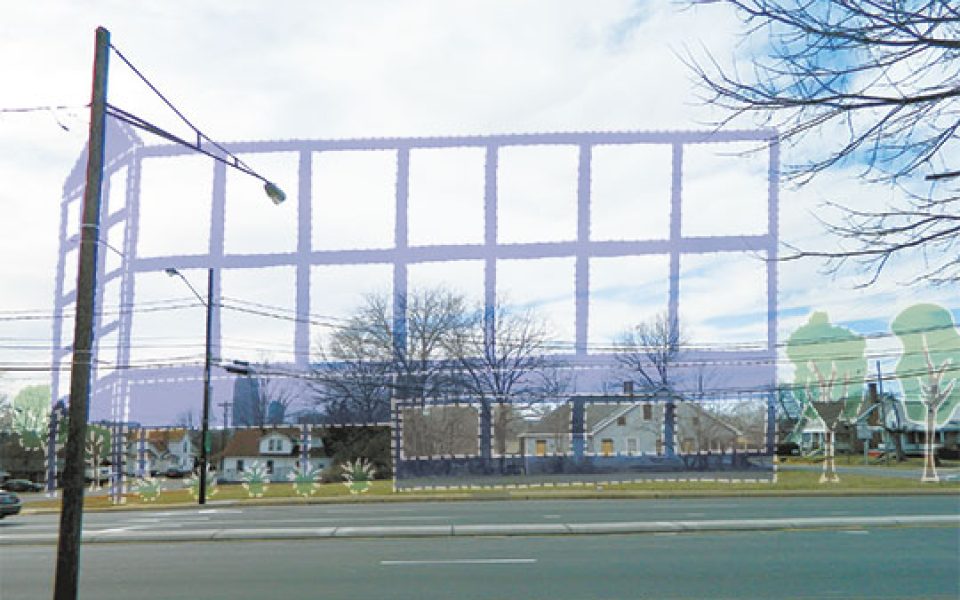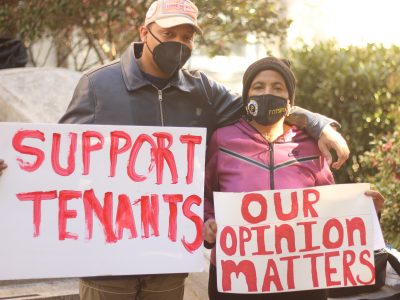Revitalization of a major corridor stalled as a city loan went sour
by Jordan Green
The project was unveiled in the early part of the last decade, at a community meeting on the east side of Winston-Salem, in an atmosphere of high hopes.
Joycelyn Johnson, a former city council representative of the East Ward, remembered 30 to 40 residents and church members from the neighborhood attending the community meeting as a developer named Ivan Robinson outlined plans to construct a three-story medical/professional building on a block of Martin Luther King Jr. Drive. As Robinson shared with city officials in a subsequent proposal to city council, the project would create about 50 full-time jobs, and provide space for an urgent-care facility and an ophthalmologist, along with a Subway restaurant.
“We really got the community energized,” Johnson recalled.
Robinson pledged to invest $3.1 million in the project, including $599,000 in owner equity. The medical center would cover most of the block on Martin Luther King Jr. Drive between Third and Fourth streets, connecting the east side to downtown. Located on the site of the former Smith Dry Cleaners, the vacant lot lies on a stretch of MLK dotted with churches and dilapidated houses roughly between the Sunrise Towers public-housing community and Forsyth Seafood. Just to the north is the intersection of New Walkertown Road, with two grocery stores. As testament to the area’s importance to the African-American community, historical markers commemorating the Local 22 union and the Black Panther Party stand within a block of the vacant lot.
Proximity to Business 40 is only one factor in the area’s potential for redevelopment; more significantly, the site sits about five blocks north of the campus of Winston-Salem State University, with more than 6,000 students and almost 1,000 full-time faculty and staff; and about eight blocks east of the burgeoning Wake Forest Innovation Quarter, a magnet for tech companies and home to the future Bailey Power Plant, conceived as a massive complex of shops, restaurants, offices and entertainment venues.
Renderings by Design Workshop on behalf of the Creative Corridors Coalition envision Martin Luther King Jr. Drive as a bustling pedestrian corridor studded with public art and new streetscaping.
Today, while the thoroughfare sees steady foot traffic, it has a hostile feel with cars zooming past, making quick turns in and out of parking lots at a gas station or the strip mall. With the impending closure of Business 40 scheduled to begin in 2016, the offset traffic load onto MLK should only worsen the pedestrian experience.
Robinson purchased the former Smith Dry Cleaners property with Michael Suggs, the executive director of Goler Community Development Corp., in 2004. Around that time, Robinson approached the city with a request for financial assistance to cover the cost of removing environmental contaminants left behind by the dry-cleaner.
The city council approved a loan of $150,000 to Developing Designs & Renovations, a company principally owned by Robinson, in May 2005, and the city paid out the funds the following year. Under the terms of the loan, the interest rate was set at 4 percent with a one-year deferment. As security for the loan, Robinson and Suggs signed over the property to the city as collateral.
Since that time, the developers never made a payment on the loan.
The city appointed a substitute trustee to bring a foreclosure action against the borrowers in early 2008, and then put efforts to recoup the investment on hold as Michael Suggs variously suggested buying out the city’s lien or finding a new developer to purchase the property. Meanwhile, by 2012, Ivan Robinson had disappeared.
“I don’t want to say it’s a misappropriation of funds,” Johnson said. “This is a big project with an inexperienced developer. I just think it may have been overwhelming.”
A zoning report for the City-County Planning Board indicates that Walgreens was interested in building a drug store on the site in 2007 as payments on the loan went delinquent, but the deal eventually fell through.
Johnson said there was also talk of Dunkin’ Donuts or another national chain opening a store on the lot, but also to no avail.
In January 2008, Assistant City Manager Derwick Paige instructed staff to initiate a foreclosure against Robinson and Suggs, according to an email from city Economic Development Specialist John L. Allen obtained by Triad City Beat through a public-records request.
Elizabeth Repetti, a lawyer appointed by the city to serve as substitute trustee, informed Suggs that the city was calling in the loan and would begin foreclosure proceedings if they didn’t receive full payment.
Yet four years later, the property remained in Robinson and Suggs’ possession and members of city staff were still debating their options for recovering the city’s investment.
“Locating one of the owners has been an issue for several years,” Paige said. “He left town and no one has been able to track him down. We worked with the local owner to find a buyer. We had several nibbles, but no actual projects came to fruition.”
Suggs, who has attempted to resolve the delinquency with city officials in the wake of Robinson’s disappearance, could not be reached for this story. As executive director of Goler CDC, he has led efforts to revitalize Goler Heights, a historically black residential neighborhood tucked between the Innovation Quarter and the Entertainment District. In that capacity, Suggs has served as chairman of the board of the Downtown Winston-Salem Partnership.
While the city’s loan went sour, records from the state Department of Environment and Natural Resources, commonly known as DENR, indicate that the site was actually remediated, fulfilling the purpose of the funds.
In July and August 2008, 750 tons of soil were removed and treated using a mobile steamer to strip contaminants out of the soil, as documented in a 2009 letter sent to Suggs by Delonda Alexander, a project engineer with DENR. The treated soil was shipped to a landfill in Michigan for disposal, and the lot was backfilled with clean compacted soil reaching three to 10 feet deep.
In February 2009, DENR installed eight monitoring wells on nearby properties and found what Alexander described as “very low levels of tetrachoroethylene,” a common soil contaminant widely used in dry-cleaning, in the groundwater.
Alexander informed Suggs that DENR would continue to monitor the site. She added that what the agency found might require a vapor barrier to mitigate environmental safety concerns for a new building.
“The site is ready for any construction that may be planned,” Alexander wrote. “Any assessment and remediation activities done at the site in the future will be done in a manner that minimizes impact to the property, building or business activities and will be done with the approval of the property owner.”
Ruben Gonzales, a business development administrator with the city, told Assistant City Manager Derwick Paige in a January 2012 email that Suggs had offered the city $80,000 to buy out its lien. Had the city accepted the offer it would have lost $70,000 of taxpayers’ money in the deal and would have surrendered its interest to a property valued at $110,000 in a 2007 private appraisal.
“I assume the land can be foreclosed on and that will force Michael to pay it off or lose title since it is pledged,” Gonzales wrote. “I assume that will be a long process since Ivan is nowhere to be found and can’t be served nor show up in court. I think if the city moves ahead officially Michael will make good on the loan, make us an acceptable offer, or lose his property without any compensation. At this point the city can’t even buy the property outright since Ivan Robinson is not here to sign anything and I don’t think Michael can sign a bill of sale for both.”
Paige indicated in an emailed response that he was ready to again move forward with foreclosure.
“I bet the state found Ivan to pay him the [right of way] they took for the road widening project,” he quipped.
In June and July 2012, Suggs was again telling city staff that he was working on a deal to sell the property, according to city emails.
“I spoke with Michael Suggs last week and he said he had updated Derwick on the process/progress of finalizing the property’s status that is tied to the loan,” Gonzales wrote on Oct. 15.
Paige responded drily: “I don’t know if update was exactly what he did. He mentioned that he was still unable to find Ivan Saul Robinson and that he is basically avoiding him. Michael suggested that he would probably just be willing to sign over this interest and that we go find him.”
On Dec. 6, at Paige’s direction, Gonzales approached City Attorney Angela Carmon for advice on having Suggs sign over his interest in the property. Carmon replied that she would need to see all the loan documents before rendering an opinion.
A month passed without word from Carmon, and Gonzales prodded her for an answer.
“Ruben: Given the fact that it will not be easy ‘divesting’ Ivan Robinson or his LLC of its interest in the property, I think we need to determine if the property is worth the effort,” Carmon wrote. “Given the previous use of the property, please find out if the property has been cleaned and cleared by the appropriate agency as well as the current value of the property.”
The debate continued via email well into the evening on Monday, Jan. 7, 2013.
“Angela, it is my understanding that the property has been completely remediated and it probably has significant value, but even if we have to sell below our cost at least we can work to get it developed if we control it, or otherwise it just sits in its current condition,” Paige wrote at 8:30 p.m.
Carmon replied at 9:41 p.m.: “Derwick, can we verify remediation, i.e. obtain copies of reports etc. Obviously, my concern is the potential liability/cost the city might incur if the property is not clean.”
In early 2013, Suggs was still waiting for an update from DENR on the condition of the property.
Meanwhile, in March, city staff learned that Ivan Robinson had surfaced.
Deputy City Attorney Al Andrews told his colleagues in the City Attorney’s office in a March 11 email that Eric Ellison, a private attorney, had brought up the defaulted loan while meeting with Andrews on another matter.
“Ellison indicated that the default has weighed heavily on Mr. Robinson’s heart and he wants to ‘make good’ on his debt and pick up on the monthly repayment option,” Andrews wrote in an email. “Ellison did indicate that Robinson would not be able to retire the entire debt in a lump nor handle extra interest/penalties.”
On May 9, Suggs received a letter from DENR. Delonda Alexander with the state agency informed him that no vapor intrusion was detected at five neighboring residences, and that the groundwater plume appeared to be stable. She outlined a few conditions for the agency to move the site to “no further action” status and close the case, including that a vapor barrier be installed and that restrictions be placed on the property to prevent it from being used as a childcare center or school. Alexander closed her letter by writing that the agency stood ready to abandon its testing wells “to clear the way for construction.”
Bryan Thompson, a substitute trustee, appointed by the city filed foreclosure papers on the property a week before Christmas.
On Monday at noon, Thompson opened the auction in the hallway of the Forsyth County Hall of Justice. Larissa Mathis, a senior financial analyst with the city of Winston-Salem, stood with her hands clasped. Charmon Baker a real-estate investor who had floated an offer of $20,000 to Mathis for the property, was there, too, although she said she hadn’t seen any prior notice of the auction.
Mathis opened the bidding on behalf of the city with $186,000, the amount of the original loan, plus interest.
“Does anyone have a bid over $186,000?” Thompson asked. “Seeing none, the hearing is closed.
“That was quick,” he added.
The case will be open for through March 20 for upset bid to any interested parties willing to put up 5 percent over $186,000. If no one else bids, the city will own some additional real estate.
Joycelyn Johnson, the former council member, said that while there appear to be no immediate prospects for redevelopment of the site, the growth of the Innovation Quarter bodes well for the corridor. It’s not farfetched to think the street could become a pedestrian-scale street again.
“That’s what it was 50 years ago,” Johnson said. “We had the dry-cleaners on the corner. There was a doctor’s office with a florist on the backside where the housing was. There was a Laundromat. People from the neighborhood would come, and we would walk there to the dry-cleaners.”
In the meantime, a Creative Corridors task force has been trying to identify places for a park where people can sit down while waiting for the bus, take an afternoon break or hold a small gathering. The city’s likely acquisition of the property creates an opportunity to set the plan in motion, Johnson said.
Derwick Paige, the assistant city manager who brought the loan request to city council in 2005 and more recently pushed to foreclose the property, has no regrets.
“Somebody had to step in and make the funds available for the cleanup,” he said. “If the project had gone forward, if we would have been able to recoup our funds immediately, we would have been able to be made whole a lot earlier. The city will through providing a development opportunity and job creation be able to recoup its investment. At some point that lot will be developed. I think the city’s funds were well used.”
Join the First Amendment Society, a membership that goes directly to funding TCB‘s newsroom.
We believe that reporting can save the world.
The TCB First Amendment Society recognizes the vital role of a free, unfettered press with a bundling of local experiences designed to build community, and unique engagements with our newsroom that will help you understand, and shape, local journalism’s critical role in uplifting the people in our cities.
All revenue goes directly into the newsroom as reporters’ salaries and freelance commissions.







I’m confused by who exactly paid for the cleanup and how much did it cost?
Steve, presumably the borrowers, Michael Suggs and Ivan Robinson, paid for the environmental remediation with the money borrowed from the city. There’s no record in the documents provided to me by the city of the cost of remediation, but the total amount of the loan — $150,000 — was designated for that purpose.